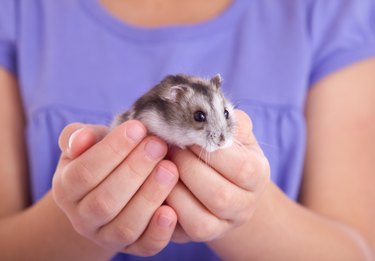Hamsters and mice are both rodents, and either make excellent small pets. Both are commonly referred to as pocket pets, which are easy to look after small animals that have shorter lifespans than other pets. Care requirements are similar between the two, but hamsters and mice have several differences including size, sociability, and disposition that make them unique pet rodents.

Video of the Day
Mouse vs. hamster
Mice belong to the rodent family Muridae, the world's largest family of mammals. Two-thirds of rodent species belong to this family of true mice and rats, which consists of almost 1,400 species.
Video of the Day
Hamsters used to be classified as their own separate rodent family. However, their relationship to mice is closer than scientists once thought, so they now belong to the Muridae subfamily Cricetinae. This subfamily consists of 18 hamster species that hail from Europe and Asia.
Physical differences in mice and hamsters
Size immediately sets mice and hamsters apart. Mice are about 3 1/2 inches long without their tails and weigh in at 1/2 to 1 ounce. The Syrian hamster, also known as the golden hamster — or teddy bear hamster if he's a long-haired variety — is substantially bigger than a mouse at 6 inches long. However, the dwarf species of hamster, including the Siberian, Chinese and Roborovsky's Djungarian, are smaller than mice at 2 to 3 inches long.
Regardless of size, hamsters have a stockier build than the slim, streamlined mouse. And hamsters are almost tailless, while mice have long tails that allow these small animals to balance when they climb or run.
Habits and lifestyle
Mice are more social than hamsters. Hamsters should be housed alone, since they often fight if you keep pairs or groups in one cage. Male mice will also fight if kept together, but mice do well in pairs or small groups of females.
Both hamsters and mice have relatively short lifespans for pets; mice live one to three years, dwarf hamsters live one to two years, and Syrian hamsters live two to three. Both types of pet rodents are nocturnal, so you can expect them to sleep most of the day and run on their exercise wheels at night.
Unless you want your pet to play Houdini and disappear somewhere into the house, both types of animals need to be kept in a cage with secure latches or a terrarium with chew-proof metal mesh lid. Their living space needs to be large enough to run around in. And since rodents like to chew, avoid plastic dishes and exercise wheels but provide plenty of safe chew toys and metal exercise wheels for all pet rodents.
Care and handling of pet rodents
Methods of handling each animal differ. When picking up your pet mouse, grasp him gently at the base of his tail near his body, and place him into your other cupped hand. Mice are more nervous and fast-moving than hamsters, so be sure not to startle your pet. Hamster tails are short and stubby, so do not try to pick up your hamster by the tail — instead, gently scoop him up in both hands, making sure not to corner him or shove your hands in his face, as he might nip.
Feed both animals a good-quality hamster food, and supply fresh water in a drinking tube or hanging water bottle. Care for both pet rodents requires daily cleaning of dishes and water bottles and weekly cage cleaning. Toys and accessories should be washed with hot soapy water when you clean the cage, and bedding changed. Use mild bleach to disinfect cage and accessories, and make sure everything is completely rinsed and dry before you put your pet back home.